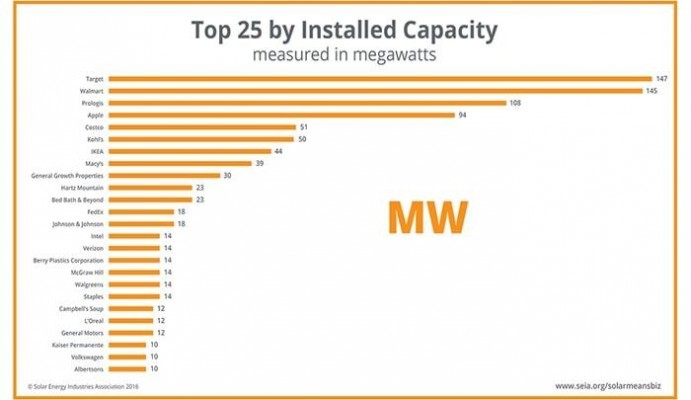Many of America’s biggest and most successful businesses have gone solar. The list includes industry giants like Wal-Mart, Target, Apple, IKEA, Macy’s, FedEx, Verizon, General Motors, L’Oreal and others. And every day, more companies, both large and small, are investing in solar as well. Why? For many, it’s to save money. But solar can also be one of the most effective ways to quickly achieve corporate sustainability goals.
Benefits of Solar Power for Business
Deciding whether solar is right for your business depends on many factors, including the regulatory environment and government incentives in your region, the suitability of your facilities, the support of your company’s leadership, and your current energy costs and rate volatility among others. And if demonstrating corporate environmental responsibility is a high priority for your organization, solar can be one of the quickest paths to achieving even the most ambitious corporate sustainability goals.
For example, installing an onsite commercial solar panel system made of low waste and responsibly-sourced materials can earn a commercial project more LEED® points than almost any other single green building initiative. (LEED, short for Leadership in Energy & Environmental Design, is the U.S. Green Building Council’s certification program that recognizes best-in-class green building strategies and practices.)
Through LEED, Zero Net Energy and Living Building programs and others, organizations of all kinds are proving solar can play an important role in achieving lofty green building standards.
Sustainability Planning
From big box retailers to manufacturers, agriculture to high tech, telecommunications to delivery services, an ever-increasing list of U.S. businesses are incorporating commercial solar power into their long-term sustainability planning.
Many top brands using solar today started along this path by setting corporate sustainability goals, energy cost savings targets, or both. They wanted to be better stewards of the environment and use energy more wisely and cost effectively. Sound familiar? Then solar is a great first option to consider because it can take an organization a long way toward achieving both goals. If you’re interested but not sure where to start, read on.
Define Your Objectives and Find a Model to Follow
As with any business goal, start by defining your objectives and then clearly delineate what success looks like. Look to others who have met or exceeded sustainability goals like yours and emulate their process as it makes sense to do so. Be prepared to innovate to solve problems specific to your industry, organization, facilities, budget or circumstances.

Top 25 businesses ranked by their total on-site installed solar capacity, or the maximum power potential measured in megawatts (MW), from SEIA’s Solar Means Business 2016 report.
Take a look at SEIA’s 2016 list of the top 25 businesses ranked by solar capacity and other companies that have gone solar. Which business is most like yours? Are you looking to power office buildings and corporate campuses like General Growth Properties or McGraw Hill? Brick-and-mortar retail buildings like Macy’s or Walgreens? Manufacturing facilities like GM or Johnson & Johnson? Data centers like Apple or Verizon? Warehouses or distribution centers like Wal-Mart or FedEx? Event venues? Agriculture? Or maybe some combination of these? There are many ways to go solar, so choosing an appropriate exemplar can help you understand what your end goal might look like.